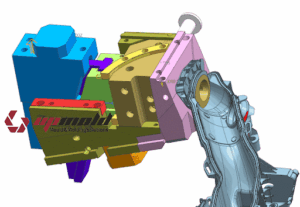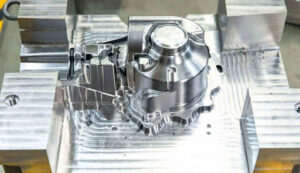TECHNOLOGY
Injection Molding Mold Design for Complex Parts: Breaking Limitations of Geometry and Structure

Injection molding is one of the most efficient processes of manufacturing parts made of plastic material. Individual parts of a product are created and joined physically since the molten material is introduced into a mold cavity. It is being used in car manufacturing companies, industries producing home appliances, and any other industries that require products of unique design.
What defines injection molding is the capacity, accuracy, and high levels of productivity in the creation of tough shapes that often possess complex cross-sectional shapes. However, the creation of these molds they want to create all those geometries proves to be complicated, and so does the strength of these structures. This article discusses the ways and means you may use to overcome these challenges and gain a seamless outcome from your bespoke injection molding solutions.
The Challenge of Complex Part Design
It is difficult to provide molds for any complex part geometry creations because of the interaction between intricate shapes and structures. Sharp edges and patterns such as undercuts, thin-walled designs, and fine surface details are possible only if the mold-making process uses separate cores or side actions to achieve a proper release of the part. This means thin walls are not only execution killers because they limit material flow and practically guarantee such issues as warping or sink marks.
The paper also stresses that achieving detailed designs for components while at the same time ensuring that they are manufacturable requires a trade-off between material characteristics and the mold’s capabilities. In order to achieve extraordinary mold design, progressive approaches, sophisticated simulation technologies, and most importantly knowledge to counter these limitations and deliver compacted intricate components.
Understanding Complex Part Geometry
Defining Complexity in Mold Design
Recessing is commonly used in the process when working with undersurface structures: ured, fine contours, thin-walled. For example, when using some components for molding, it is difficult to incorporate internal thread or lattice forms based on the current state.
Material Selection and Its Impact on Geometry
Different materials play a significant role in the design of the mold. For instance, some plastics shrink at higher rates or possess low flexibility, which is a big issue when molding. Knowledge of material characteristics allows a designer to meet the geometric requirements on one hand while still making the part manufacturable on the other.
Designing for Manufacturability
To refine Manufacturability, design aspects must include elements like draft angles and uniform wall thickness. These features make ejection easier, reduce the area of stress concentration, and ultimately eliminate defects such as warping.

Strategies to Address Geometric Constraints
Draft Angles and Wall Thickness Optimization
The wall thickness consistency is also critical for the material and structure to flow. Further, draft angles are incorporated in correct positions, so there will not be any difficulty in ejecting the formed parts from the mold.
Incorporating Undercuts and Threads
Techniques of varying such features involve specific techniques that include the use of collapsible cores and sliders to mold undercuts and threaded features. These tools simplify the process without affecting part design.
Using CAD and Simulation Tools
However, advanced CAD(Computer Aided Design) and simulation technologies are required in mold design in the present generation. They enable you to model geometric problems, get test results, and optimize models before committing to manufacturing. For instance, by using software, firms can guarantee that their injection molding mold design satisfies functionally and aesthetically.
Overcoming Structural Challenges in Mold Design
Reinforcing Structural Integrity
Incorporate ribs, gussets, sands in your design to come with some strength. These reinforcements also cut the amount of material that is needed and, at the same time, increase load-carrying capacity.
Cooling System Design
One of them consists in a proper temperature regulation because sink marks or warping can be ineradicable at a certain stage of work. Good design of cooling systems and good thermal management result in better product quality with fewer shots.
Gate Placement and Flow Control
The feed presentation is equally filled, and the gates are appropriately arranged to regulate material flow and minimize weld lines. An optimized gating system has a very close relationship with the life and appearance of the end product of a part.
Advanced Solutions for Complex Molds
Multi-Cavity and Family Molds
Based on this type of mold, many parts can be manufactured at once thus increasing the rate of manufacture. Regarding designs with element splitting, family molds can form several parts using one mold layout.
Use of 3D Printing in Mold Fabrication
Due to advancements in the 3D printing industry, the approach to generating custom molds is changing. Through the creation of cost-efficient prototype molds, there is little time used when manufacturers are developing a design to its final stage.
In other words, the primary value of this innovation is that it is useful when making modifications in the custom injection molding process, and contributes toward precision in the work.
Hybrid Mold Technologies
CNC machining and additive manufacturing combine benefits characteristic for both techniques in order to construct hybrid molds. These molds use the strengths of both traditional and advanced technologies: They are relatively sturdy but quite adaptable simultaneously.

Conclusion
To effectively address problems that may arise with injection molding mold design,more focus must be given on draft angles, CAD, use of support structures. This guarantees efficiency and quality as the company can tap on high tech solutions such as 3D printing and hybrid solutions.
The future of mold design involves using simulation prepared primarily by artificial systems, advancement in material science, and environmentally friendly manufacturing strategies. This means that you can handle the most challenging part of designs no matter how advanced they are if only you do away with the guesswork and update with the new trends in design.
It has been established as a ready source of ready-to-use designs for anyone interested in giving their mold designs a makeover. Discover more about the highly developed products in our custom mold & design inc and increase your manufacturing processes’ accuracy and productivity.
TECHNOLOGY
5 Features to Look for in a Trading Platform That Will Boost Your Performance

Imagine executing a trade in milliseconds, backed by crystal-clear charts, smart alerts, and zero frustration. The right trading platform can turn that vision into reality, elevating accuracy, speed, and confidence on every order. That’s why finding a truly user-friendly trading platform is more than convenience—it’s a competitive edge.
Trading moves quickly, and markets rarely pause for second-guessing. A platform that enhances decision-making can deliver better results by giving traders the right data, tools, and execution capabilities exactly when they are needed. It can save valuable seconds during volatile swings, reduce costly errors through intuitive design, and enable smart, calculated moves at precisely the right moment. In an environment where every click matters, the platform you choose becomes not just a tool but a critical partner in your performance.
Key Features to Look for in a Trading Platform to Level Up Your Performance
1. Lightning-Fast Execution and Low Latency
Execution speed can make or break a trade. A delay of even a few milliseconds might turn a winning opportunity into a missed chance, especially in volatile markets where prices can shift in the blink of an eye. Fast execution ensures that orders are filled at the intended price, reducing slippage and improving consistency.
What to look for:
- Real-time order routing to exchanges or liquidity pools for the fastest fills possible.
- Minimal latency (ideally under 50 milliseconds round-trip) to keep pace with rapid market movements.
- Buffering or fallback mechanisms to ensure execution during traffic surges or connection drops.
A quick execution engine is the backbone of any high-performance trading platform. That speed is especially vital for active traders and day traders, whether using a regional provider or considering different platforms in the UAE. When seconds can define the success of a strategy, low-latency execution is not just an advantage—it’s a necessity.
2. Advanced Charting with Intuitive Design
Detailed charts mean nothing if they become confusing under pressure. The best platforms strike a balance between analytical depth and easy-to-use interfaces, helping traders react swiftly without information overload. Clear visuals and intuitive navigation make it easier to read market conditions, spot patterns, and identify entry and exit points.
Must-have charting features:
- Multiple timeline options (from ticks to months) to suit both short- and long-term strategies.
- Common indicators (e.g., moving averages, RSI) for quick technical analysis.
- Customizable overlays, templates, and layouts for a personalized workspace.
- One-click switching between views and asset classes for multi-market trading.
An intuitive yet powerful charting interface turns analysis into action. When the platform is a user-friendly trading platform, visual clarity helps maintain focus and prevents costly misinterpretations. Clean visuals, responsive zoom, and a distraction-free layout make charting tools genuinely useful, not just attractive.
3. Smart Trade Automation & Alerts
Markets rarely wait for attention. A well-equipped platform should offer automation tools and alert systems that allow traders to set predefined conditions, minimizing missed opportunities and reducing the need for constant screen-watching.
Valuable automation tools:
- Conditional orders (e.g., stop-limit, trailing stop) to manage trades without manual intervention.
- Price, volume, or news-driven alerts delivered instantly via desktop or mobile.
- Scripting or strategy automation pipelines for advanced custom setups.
Even professionals appreciate reminders. For instance, a recent survey by Finance Magnates Intelligence found that 64% of active traders rely on automated alerts to manage market risk. That automation frees mental bandwidth and helps capture opportunities swiftly.
When evaluating a trading platform provider, checking automation depth ensures readiness for both current needs and future scaling.
4. Transparent Fees and Flexible Account Management
Surprise fees can quietly erode performance gains over time. A trustworthy platform will clearly present its pricing, ensuring that traders know exactly what they’re paying before placing a trade.
Account and fee transparency:
- Published spreads, commissions, and swap rates in an easily accessible format.
- Clear disclosure of deposit/withdrawal fees, with no hidden costs.
- Tiered account types (standard, ECN, VIP) with clearly defined benefits.
- Demo or simulated accounts are available without restrictions for testing strategies.
Clarity builds trust. Whether searching for trading platforms in the UAE or evaluating options worldwide, transparency in pricing and account structures is essential. A platform that offers demo accounts allows beginners to learn without financial risk, while experienced traders can test new strategies under real market conditions before committing capital.
5. Mobile Compatibility with Seamless Synchronization
Trading doesn’t pause when you step away from your desk. A robust mobile component ensures that you can monitor markets, manage positions, and act on opportunities wherever you are.
Key mobile features:
- Real-time data and notifications are in sync with the desktop version for consistent tracking.
- A responsive interface with full access to core trading tools—no stripped-down versions.
- Secure login options like biometrics or two-factor authentication to safeguard accounts.
- Offline order drafting that executes automatically once back online.
A mobile version is only valuable if it mirrors desktop performance without compromising speed or usability. For a truly user-friendly trading platform, mobile access should feel just as reliable and capable as trading on a larger screen, ensuring you never miss a chance to act, even on the go.
Why These Five Matter for Performance
Each feature supports a critical aspect of trading excellence:
| Feature | Performance Benefit |
| Fast Execution | Captures opportunities before others react |
| Intuitive Charts | Reduces mistakes and speeds analysis |
| Smart Alerts/Automation | Manages risk proactively, reduces stress |
| Transparent Fees | Avoids surprises, preserves profitability |
| Mobile Sync | Seizes opportunities anywhere, anytime |
Together, they form a cohesive toolkit—one that empowers confident, timely, and informed trades. A trading platform that nails these isn’t just a tool—it becomes a partner.
Practical Steps to Apply These Criteria
- Shortlist platforms: Use search terms like “trading platforms in UAE” or “trading platform provider” to narrow down reputable options.
- Test with a demo: Focus testing on speed, chart usability, automation options, fee clarity, and mobile parity.
- Compare side by side: Evaluate forgiveness for slow inputs, clarity in fee breakdowns, and how alerts appear on mobile versus desktop.
- Look for independent feedback: Forums, professional reviews, or verified trader testimonials often highlight hidden strengths or weaknesses.
- Track usability under pressure: Use a mock trade scenario to simulate volatility and responsiveness—see where delays or confusion arise.
Final Thoughts
Selecting the right trading platform isn’t just about branding or flashy features—it’s about building a foundation for consistent, smart performance. Look for:
- Speed you can trust—because every millisecond counts.
- Charts that clarify, not confuse—so decisions stay sharp.
- Automation that supports, not replaces, judgment.
- Pricing clarity that protects every pip you earn.
- Seamless mobility—so opportunity isn’t location-dependent.
Whether doing research on trading platforms in the UAE or evaluating offerings from any trading solution provider, these five features serve as a performance-boosting checklist. A well-designed trading platform might feel simple on the surface, but it’s built on powerful, reliable systems under the hood. Choose one that supports performance, not just promises it.
TECHNOLOGY
Charlotte Web Design That’s as Strategic as It Is Stunning

When Looks Aren’t Enough
A site can look great, but if it doesn’t bring in customers or move your goals forward, it’s just decoration. Too many brands dive into Charlotte web design, focusing only on style—fonts, colors, and maybe some animation—while missing the bigger picture: performance. Real design is about more than just looks; it’s about how the site works for both people and the business. That means building in SEO, fast load times, mobile readiness, and accessibility from the very start. Above Bits has been building custom websites in Charlotte long enough to know what actually moves the needle. We’ve helped companies that once relied on flashy templates rebuild from the ground up with results-focused design, and their bounce rates and conversions prove it. We treat websites like assets, not art projects—and that shift in mindset changes everything. Let’s examine what truly distinguishes strategic web design from the rest.
Design with a Brain: Why Strategy Comes First
Looks Won’t Save You Without a Game Plan
You’ve seen them—those gorgeous websites that win awards but struggle to generate a single lead. That’s what happens when design leads strategy, not the other way around. A strategic approach to Charlotte web design starts with understanding the business model behind the brand. What are the site’s goals? Who are the visitors? What’s the conversion path? Until those answers are clear, picking out fonts and colors is just noise. At Above Bits, we design every page, button, and flow with a clear goal in mind. Whether it’s booking an appointment, downloading something, or completing a purchase, every action should link to a clear goal. Without that, you risk a site that looks nice but doesn’t get used—or worse, one that drives people off.
Charlotte Web Design That’s Built to Deliver
Strategic websites do more than look good—they carry real business weight. At Above Bits, our Charlotte web design projects start with listening, thorough research, and meticulous planning. We map out what your users need, what your business wants, and how we can make both happen smoothly. We aren’t here to sell you a pixel-perfect homepage that doesn’t perform. We’re here to build a system that works as hard as you do, from the homepage to the backend CMS. That includes understanding local industries in North Carolina, from healthcare to real estate to professional services, and tailoring the experience accordingly. A site that converts in Raleigh may not resonate the same way in Charlotte, and we build with those regional nuances in mind. That’s the kind of design that works for your bottom line—not just your brand guide.
The Power of UX: Guiding Visitors to Action
Don’t Let Users Get Lost in the Pretty
Good UX is what keeps people moving forward. If they can’t find the contact form, get lost in the navigation, or feel crowded by the design, they’ll leave. And in Charlotte, with tough competition and high expectations, bad UX doesn’t just annoy people—it costs you money. Our design process at Above Bits prioritizes the user above all else. That doesn’t mean dumbing things down—it means removing friction, highlighting paths, and making clever use of whitespace and hierarchy. We’ve seen brands double their lead generation just by rethinking their UX. It’s less about gimmicks, more about clarity. And if your site isn’t intuitive, your next customer may never become a customer at all.
Charlotte Web Design That Moves Like Your Users Do
People don’t scroll like they used to, and we track that. We analyze where users drop off, which elements they engage with, and how they actually use your site in the real world. Our Charlotte web design philosophy is grounded in behavioral data—heatmaps, session recordings, click-through paths—so we’re not designing in the dark. Whether your audience is on mobile during a coffee break in Uptown or browsing from a desktop in Greensboro, your site has to adapt. That means sticky navbars, quick load times, and layouts that never leave the user guessing. Our goal is to make your site feel effortless—even when it’s doing a hundred things under the hood. In UX, the magic is in the details most people don’t even notice—until something’s broken.
Infrastructure Matters: What’s Behind the Curtain
A Fast Site Isn’t Optional Anymore

It doesn’t matter how stunning your homepage is if it takes six seconds to load on a phone. Users won’t wait, and Google won’t either. Speed is now a ranking factor, and Charlotte web design that overlooks performance is a liability. At Above Bits, we build on lightweight frameworks, compress assets correctly, and avoid unnecessary scripts that drag you down. We’ve seen sites jump multiple positions in search just by shaving milliseconds off their load times. When we audit existing websites, visual design is rarely the most significant issue—it’s almost always technical debt hiding in the backend.
Here’s what usually tanks site performance before we touch it:
- Bloated JavaScript libraries are loading on every page
- Massive, uncompressed images that should’ve been WebP
- Excessive third-party plugins are choking the rendering path
- Render-blocking CSS is buried in outdated themes
- Cheap hosting with high TTFB (Time to First Byte).
Fast sites don’t just rank better—they convert better, too. That makes optimization not just a tech problem, but a business strategy.
What You Get With Speed-First Charlotte Web Design
We get hands-on with performance. Before launch, we test how quickly the site starts loading, ensure the layout doesn’t jump around, and verify that the main content appears quickly. We also tune performance on the server side, using AlmaLinux or cloud hosting, where we can control every detail. We prioritize reducing unused CSS, implementing lazy-loading assets, and setting cache headers correctly to optimize performance. This isn’t just developer talk—it’s performance that translates to real results. Businesses in North Carolina that we’ve worked with have seen up to a 70% improvement in bounce rates simply from infrastructure upgrades. We don’t believe in the “just install a plugin” approach. Performance is planned, measured, and engineered—and that’s precisely what we deliver.
Mobile Comes First (Because It Already Did)
The Thumb Generation Doesn’t Forgive Bad Design
Over 60% of users are mobile-first now, and yet we still see Charlotte businesses launching desktop-first designs. It’s a mistake that costs conversions every day. If your site isn’t built for thumbs, tap zones, and short attention spans, you’re not even in the game. Mobile design is about more than resizing—it’s about behavior. People on mobile are often multitasking, moving fast, and expecting instant gratification. That means cleaner interfaces, faster loading, and easy navigation. At Above Bits, our Charlotte web design team starts mobile and scales up, not the other way around. This “mobile-first” mentality is baked into every layout we touch. It’s not just best practice anymore—it’s survival.
Charlotte Web Design That Works in Your Pocket
We test every website on real devices—not just emulators—before launch. That includes iPhones, Androids, tablets, and every odd screen size in between. We simulate weak connections, test in sunlight, and even account for one-handed usage. Why? Because that’s how people browse in the real world—at the airport, in the car (hopefully parked), or standing in line at a Charlotte coffee shop. Our design adjusts content spacing, font sizes, button padding, and image scaling to meet real-world demands. We’ve even built mobile-specific features, such as tap-to-call and collapsible menus, tailored to user intent. Great Charlotte web design doesn’t just shrink—it adapts. And that adaptability is what drives real engagement on the go.
SEO-Ready from the Ground Up
Your Site Can’t Rank If Google Can’t Read It
A lot of businesses in North Carolina spend big on a new website, only to realize later that it doesn’t show up in search. SEO isn’t an afterthought—it has to be part of the design from day one. That means innovative URL structures, semantic HTML, schema markup, optimized headings, and fast loading times across every device. At Above Bits, we make sure Google doesn’t just crawl your site—it understands it. We’ve worked with companies across Charlotte, Durham, and Greensboro that had sleek designs that performed terribly in search. In most cases, it wasn’t their content that was the issue—it was their code, structure, and speed.
Web design without SEO is like a car without an engine: it might look good in the driveway, but it’s not going anywhere. That’s why our design team collaborates directly with our SEO team during the planning phase, not after launch. Every element, from how we name image files to how we set up page hierarchies, is built for discoverability. And yes, we absolutely audit every site before redesigning it to identify the search performance gaps. With search trends constantly shifting in North Carolina’s competitive markets, your website needs to evolve, too. What ranked last year might be holding you back today. We don’t guess—we test, iterate, and make SEO part of your site’s DNA.
Charlotte Web Design That Speaks Search
Search engines are constantly evolving, and web design must adapt to them. Our Charlotte web design process includes structured data implementation, optimized page load order, and the kind of internal linking that search engines (and users) love. For example, instead of generic “Learn More” buttons everywhere, we design contextual CTAs that clarify the value of the next click. We’ve rebuilt websites for companies in Raleigh and Asheville that saw traffic double just from backend improvements—before a single new blog was written. It’s not magic; it’s clarity, structure, and planning.
Google is favoring mobile usability, accessibility, and high-performance code more than ever—and all of that falls under the designer’s job. We ensure every element serves a dual purpose: aesthetic and strategic. That includes using heading tags correctly (no more H1s in every section), minimizing duplicate content issues, and even optimizing for Google’s Core Web Vitals. In the end, we don’t just build a site that looks good—we make one that works hard for your rankings 24/7. Because let’s be honest, what’s the point of great design if no one sees it?
WordPress vs. Custom: Making the Right Choice
Flexibility Comes with Tradeoffs
Some clients walk in thinking WordPress is the only option. Others want something completely custom, even if their needs don’t justify it. At Above Bits, we take a practical approach—what matters is what will serve you best in the long term. Most people like WordPress because it’s straightforward, comes with a mountain of plugins, and has a community that answers just about any question you throw at it. It’s perfect if your team wants control without needing to learn how to code. The problem with WordPress arises when you load it up with plugins or stick with a clunky theme — that’s when the site starts to drag. A custom CMS avoids much of that and usually runs faster as it scales, but it does mean having developers on hand to keep everything running smoothly.
There’s no single correct answer. What works for a small real estate office in Huntersville might flop for a fast-growing SaaS company in Charlotte’s tech corridor. Our job isn’t to push one option—it’s to find the best fit. We assess your needs, budget, performance goals, and growth plans to recommend the ideal setup. And we’ll never push a platform just because it’s our comfort zone. We know both worlds, and we lay out the trade-offs clearly, backed by real data.
Charlotte Web Design: WordPress or Custom? Let’s Compare

Here’s a quick comparison of the two approaches we most often recommend in Charlotte web design:
| Feature | WordPress | Custom CMS/Web App |
| Ease of Use | Intuitive for most users | Requires training/documentation |
| Cost to Launch | Lower upfront | Higher initial development costs |
| Performance | Can vary based on theme/plugins | Highly optimized, built from scratch |
| Security | Dependent on plugin quality | Tighter control, fewer attack vectors |
| Scalability | Good with managed hosting | Excellent for high-growth platforms |
| Ongoing Maintenance | Frequent plugin updates are required | Developer-driven updates, less frequent |
It’s not about which is better—it’s about which is right for your project. And we’ll help you figure that out before the first line of code is written.
Real Collaboration Means Better Results
We Don’t Design in a Vacuum
The most successful Charlotte web design projects we’ve delivered didn’t come from a blank slate—they came from conversations. We involve your team early, often, and in a practical sense. No jargon walls, no endless back-and-forths over fonts. We present you with sketches, wireframes, and early-stage layouts, and we translate your feedback into actionable steps. And because Above Bits is a local team, we’re available for in-person strategy sessions, coffee meetings, or video calls that feel like real collaboration—not outsourced chaos.
Designers aren’t mind-readers, and you shouldn’t have to become a tech expert to explain what you want. We speak both business and dev fluently, bridging the gap between vision and execution. We ask fundamental questions: What frustrates your customers at the moment? What’s missing in your current site? What metrics actually matter to you? These conversations don’t just influence design—they define it. And in North Carolina’s fast-paced markets, especially in cities like Charlotte and Cary, having a responsive design team that listens can be your unfair advantage.
Charlotte Web Design Clients Get a Partner, Not Just a Vendor
Above Bits isn’t here to drop a website on your lap and vanish. We stick around. From training your staff on the CMS to helping you monitor analytics, we stay available long after launch. A lot of our Charlotte web design clients end up sticking with us for years, and that’s no accident. We keep things straightforward, stay flexible, and focus on results that truly matter for your business, rather than just checking boxes. Sometimes that means running A/B tests to see what really works, sometimes it’s creating seasonal landing pages, and other times it’s analyzing conversion funnels to improve how people navigate your site.
We know web design isn’t “set it and forget it.” Algorithms change. Customer behavior evolves. Tech stacks move fast. That’s why we offer continuous support plans for North Carolina clients who want more than a pretty site—they want digital growth. Whether you need performance tuning, SEO support, or a complete redesign two years down the line, we’re right here in Charlotte, ready to go. Because the real win isn’t launch day—it’s everything that comes after.
Built With Intent, Backed by Above Bits
Design That Doesn’t Just Sit There—It Works
We’ve seen too many websites in Charlotte with no real plan behind them—just color, layout, and a few trendy animations. At Above Bits, we don’t believe in “just looking good.” Every decision is intentional. Every design element—from spacing to button size to font pairing—is meant to support your business goals. This isn’t a design trend playground; it’s a tool that should drive leads, sales, calls, or engagement. Our design team reviews data before we start working with pixels. We test layouts with users. We iterate. It’s not glamorous, but it’s what makes the difference between “meh” and money.
If your current site was built just to check a box, you’ll know it. Leads trickle in. Bounce rates climb. Load times crawl. Our Charlotte web design strategy reclaims those lost opportunities and reinvests in performance, UX, and branding that work together effectively. We don’t use jargon or confuse clients with tech layers. We show you what matters and we prove it with outcomes. That’s the kind of approach that builds businesses—not just websites.
Your Next Site Starts With a Conversation
Whether you’re a law firm in downtown Charlotte or an e-commerce shop growing out of Greensboro, the first step to a better website is simple—we sit down and talk. No hard pitch, no vague promises—just a strategy session to see where your current site stands and how it could perform better. At Above Bits, we believe the best client relationships begin with listening, and we’ll never force you into a service you don’t need. We offer audits, mockups, prototypes, and honest feedback—even if that means telling you not to redesign yet.
Our team is rooted in North Carolina and passionate about building tech that lasts. With every project, we bring 20+ years of web experience, a flair for creative problem-solving, and a whole lot of coffee-fueled late nights. If you’re ready to upgrade your digital presence with Charlotte web design that’s built with purpose, not just polish—Above Bits is the team that gets it done.
TECHNOLOGY
Puckipuppy Rottweiler: Redefining Stability and Comfort in Electric Trikes

Electric tricycles, or three-wheel electric bikes, have been steadily growing in popularity as an alternative to traditional bicycles and cars. They offer stability and versatility, making them an excellent choice for riders of all ages and abilities. However, many electric trikes for adults on the market still struggle to provide the level of comfort, stability, and practical features that riders truly need. Whether it’s a bumpy ride, difficulty maneuvering tight spaces, or lack of power when carrying heavy loads, these issues often cause frustration.
Enter the Puckipuppy Rottweiler—a revolutionary electric tricycle designed specifically to address these challenges. With a focus on real-world usability, Rottweiler offers unmatched stability, comfort, and safety, making it the ideal choice for riders seeking a high-performance three-wheel electric bike that can handle a variety of everyday tasks.
The Challenge of Stability and Comfort in Electric Trikes
While many electric tricycles provide basic functionality, most electric trikes for adults face significant challenges when it comes to comfort and stability. Issues like poor suspension, difficult maneuvering, and the inability to handle uneven terrain or heavy loads are common problems that many riders encounter. For those who use their trikes for daily commuting, shopping, or leisure rides, these problems can become a major obstacle.
With the Puckipuppy Rottweiler, we’ve designed an electric tricycle that not only addresses these issues but redefines the entire riding experience. From the suspension system to the reverse button, every feature is built with real-world applications in mind, ensuring a smooth, stable, and enjoyable ride.
Key Features of the Puckipuppy Rottweiler That Redefine Stability and Comfort
Full Suspension System: Front Fork and Dual Rear Shocks
One of the key features of the Rottweiler electric tricycle is its full suspension system, which includes a front fork and dual rear shocks. Traditional three-wheel electric bikes often have minimal suspension, making the ride bumpy and uncomfortable, especially on rough roads. However, the Rottweiler uses advanced suspension technology to absorb shocks at every point of contact with the road.
Whether you’re riding over speed bumps, navigating tree-lined paths, or simply cruising on uneven surfaces, the Rottweiler guarantees a smooth, steady ride. This suspension system also helps distribute weight evenly, ensuring the trike remains balanced even when carrying heavy loads or passengers.
Precision Differential for Safer, More Balanced Turns
Stability during turns is another common issue faced by riders of electric trikes for adults. On many traditional three-wheel electric bikes, the rear wheels spin at the same speed, which can lead to slipping or tipping over, especially when turning at higher speeds. The Rottweiler addresses this with a precision differential, which automatically adjusts the power between the inner and outer rear wheels during a turn.
This innovation ensures that the Rottweiler remains stable and easy to control, even in tight or busy areas. Whether you’re making a U-turn in heavy traffic or navigating a crowded parking lot, you’ll feel fully in control of your ride.
Ergonomic Butterfly Handlebars for Maximum Comfort
Comfort isn’t just about suspension—it’s also about how the rider interacts with the bike. Many electric trikes for adults can cause discomfort during long rides due to poorly designed handlebars. The Rottweiler features ergonomically designed butterfly handlebars, which promote a more natural riding posture. These handlebars reduce strain on the wrists, shoulders, and back, making the ride more enjoyable, even during longer commutes.
The ergonomic design also allows for multiple grip positions, so you can adjust your posture to suit your comfort level. Whether you’re riding for a few minutes or a few hours, the Rottweiler ensures that you stay comfortable the entire time.
Reverse Button for Easy Maneuvering
One of the most practical features of the Rottweiler is its reverse button, which makes maneuvering in tight spaces effortless. Reversing a traditional three-wheel electric bike can be a challenge, especially if you’re carrying cargo or passengers. With the Rottweiler, a simple press of the reverse button smoothly moves the trike backward, without the need to get off or adjust the direction.
This makes parking, turning around in tight spaces, and backing out of garages much easier, allowing you to focus on enjoying your ride rather than worrying about maneuvering.
Enhanced Safety Features for Peace of Mind
Safety is always a priority, especially when riding an electric tricycle. The Puckipuppy Rottweiler is equipped with several advanced safety features to ensure that every ride is as safe as it is enjoyable.
Hydraulic Disc Brakes and One-Touch Parking Brake
The Rottweiler features high-performance hydraulic disc brakes, which provide faster, more precise stopping power than traditional cable brakes. This is particularly important when riding in challenging conditions or on slippery roads. For added convenience, the Rottweiler also includes a one-touch parking brake, which locks the trike securely in place with a single press of a button. Whether you’re parked on a slope or in a crowded area, you can walk away from your three-wheel electric bike with peace of mind.
Smart Visibility System
The Rottweiler is designed with visibility in mind, ensuring that you’re seen by others while riding, no matter the time of day. The high-definition LED display gives you real-time information about your speed, battery level, and gear, ensuring that you’re always aware of your riding status. Additionally, the dual front lights provide enhanced visibility at night, while the dynamic rear turn signals make it easy to signal your intentions to other riders and drivers.
Who Benefits from the Puckipuppy Rottweiler?
The Puckipuppy Rottweiler is perfect for a wide variety of riders, from families to commuters to seniors. Whether you’re looking for an efficient electric tricycle for daily errands, a stable ride for your kids, or a comfortable option for seniors with mobility challenges, the Rottweiler is built to meet all these needs.
Families and Commuters: Whether you’re using your three-wheel electric bike to carry groceries, transport kids, or commute to work, the Rottweiler offers the perfect blend of comfort, stability, and practicality.
Seniors and Riders with Mobility Issues: The Rottweiler’s stability, comfort, and ease of use make it an ideal choice for older riders or anyone with mobility concerns.
Conclusion
The Puckipuppy Rottweiler isn’t just another electric tricycle—it’s a three-wheel electric bike that redefines what an electric trike can be. With its full suspension system, precision differential, ergonomic design, and user-friendly features, it delivers a ride that is not only smooth and comfortable but also safe and practical. Whether you’re commuting, shopping, or enjoying a weekend ride, the Rottweiler is the perfect companion for every journey.
If you’re in the market for a high-performance electric tricycle that meets all your needs, look no further than the Puckipuppy Rottweiler.

 Cartoon2 months ago
Cartoon2 months agoUnlocking the Potential of Nekopoi.care: A Comprehensive Guide

 Game1 year ago
Game1 year agoExploring Aopickleballthietke.com: Your Ultimate Pickleball Destination

 BUSINESS1 year ago
BUSINESS1 year agoUnraveling the Mystery of 405 Howard Street San Francisco charge on Credit Card

 BUSINESS2 months ago
BUSINESS2 months agoWhat Companies Are In The Consumer Services Field

 HOME IMPROVEMENT2 years ago
HOME IMPROVEMENT2 years agoVtrahe vs. Other Platforms: Which One Reigns Supreme?

 ENTERTAINMENT1 year ago
ENTERTAINMENT1 year agoUnderstanding Bunkr Album: A Comprehensive Guide

 TECHNOLOGY1 year ago
TECHNOLOGY1 year agoThe Guide to Using Anon Vault for Secure Data Storage

 ENTERTAINMENT1 year ago
ENTERTAINMENT1 year agoThe Ultimate Guide to MP3Juices: Free Music Download

















